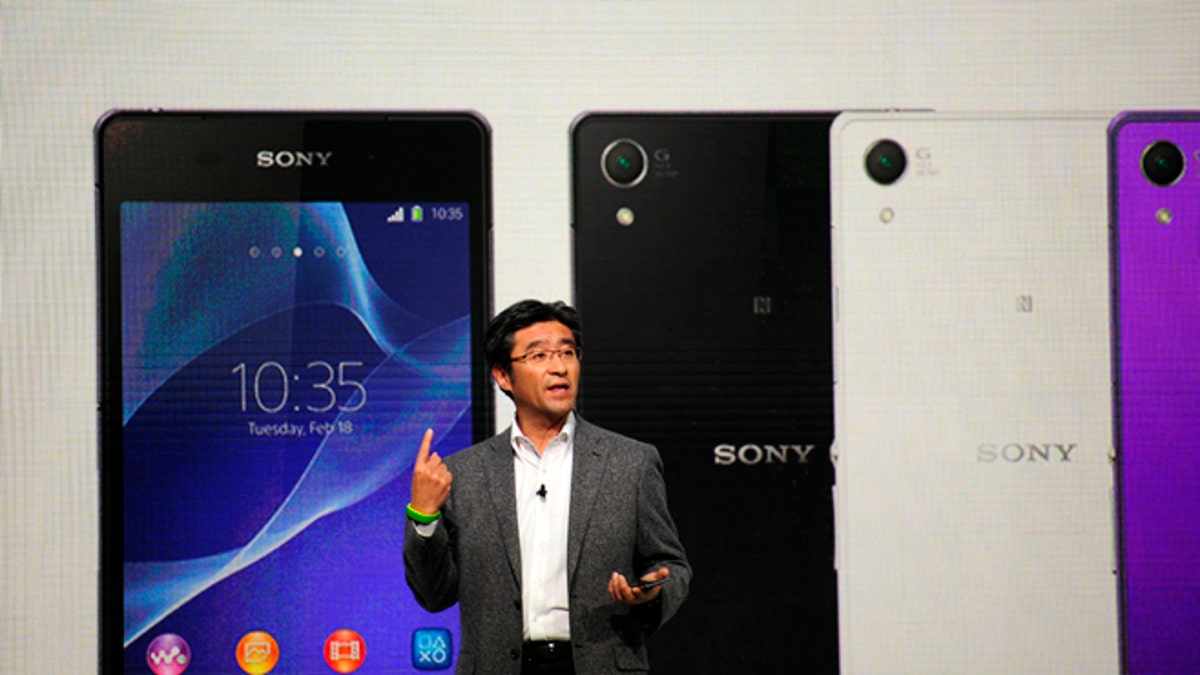
President and CEO of Sony Mobile Communications Kunimasa Suzuki presents the Smartphone Xperia Z2 during the Mobile World Congress, the world's largest mobile phone trade show in Barcelona, Spain, Monday, Feb. 24, 2014. (AP)
BARCELONA, Spain – Sony is borrowing innovations from its audio and camcorder businesses and incorporating its new Xperia Z2 smartphone with noise-cancelling technology and ultra-high-definition video recording.
Noise cancellation works with an in-ear headset sold separately for $82, while the Z2's built-in camera can capture video in so-called 4K resolution, an emerging technology that offers four times the details as current high-definition video.
Kazuo Hirai, president and CEO of Sony Corp., described Sony's new lineup as "products that are built on the shoulders of 60 years of design, engineering and artistic excellence."
Monday's announcement at the Mobile World Congress wireless show in Barcelona, Spain, comes just weeks after Sony said it was selling its Vaio personal computer operations and making its Bravia TV business a subsidiary company. Sony also plans to cut its global workforce by about 3 percent, or 5,000 people, by the end of March 2015.
More: Samsung unveils new smartwatches with fitness features
Sony, once an electronics powerhouse when its Walkman music players defined what portable gadgets should be, has had trouble keeping up with Samsung and other rivals in various consumer electronics.
Phones are no different. Despite favorable reviews, Sony phones haven't had much traction in an industry dominated by Apple Inc. and Samsung Electronics Co.
With the Z2, Sony is trying to innovate on hardware, while many of the groundbreaking features in rival devices have been in their software.
The Z2 sports the same 20.7 megapixel camera found in its predecessors, the Z1 and the Z1s. Most other smartphone cameras have 8 to 13 megapixels. The Z2 is waterproof, like the Z1 phones. Its screen is slightly larger, at 5.2 inches diagonally instead of 5 inches, but overall size is roughly the same.
Sony is boasting that the phone reproduces colors more naturally, thanks to the use of Bravia TV technology. As an example of the integration with other businesses, Sony Mobile President Kunimasa Suzuki said a few engineers from the television team worked with the mobile engineers to adjust coloring, vividness and other qualities.
In an interview, Suzuki said Sony can innovate quickly because it has expertise in-house.
Sony also unveiled a SmartBand fitness accessory that works with a Lifelog app on the phone to record your day. You see key moments on a timeline, including photos taken and messages sent and received. As your day progresses on the timeline, you see the number of steps and calories burned to that point.
The SmartBand will sell for $136, while the price for the Z2 wasn't announced. Both will be available in March, although Sony didn't disclose specific U.S. plans. Sony sometimes makes devices available in the U.S. later than elsewhere around the world.
Sony also announced a high-end tablet and a separate, mid-range smartphone.
The tablet is also called the Xperia Z2 and features a 10.1-inch screen, larger than most full-size tablets. The Wi-Fi-only model, which is waterproof, weighs 0.94 pound, lighter than Apple's lightweight iPad Air, despite the Z2's larger size. The tablet is also coming in March.
Sony's Xperia M2 handset, meanwhile, is meant as a cheaper alternative to the Z2. Its camera isn't as powerful, at only 8 megapixels, and the screen is only 4.8 inches. Still, the camera is the same as what the iPhone offers, and it's larger than the iPhone's 4 inches. The M2 is coming in April.
Sony is making a version of the M2 with two SIM card slots, something in demand in emerging markets, where plans vary so much that people often have service with multiple carriers and use what's most economical for the circumstance.
Sony said nothing about price and U.S. availability of either device.
